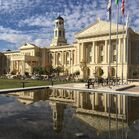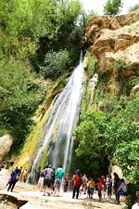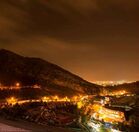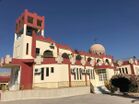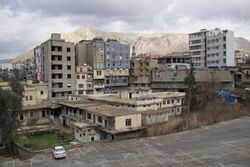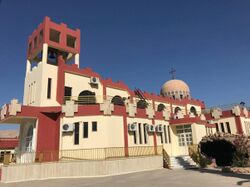Duhok
Topic: Place
 From HandWiki - Reading time: 4 min
From HandWiki - Reading time: 4 min
Duhok Dihok | |
|---|---|
City | |
|
Top-bottom, R-L:View over Dohuk American University of Dohuk • Sharansh Waterfall Dohuk at night • Assyrian Mar Narsai Church | |
| Coordinates: [ ⚑ ] : 36°52′N 43°0′E / 36.867°N 43°E | |
| Country | |
| Region | Kurdistan Region |
| Governorate | Duhok Governorate |
| District | Duhok District |
| Government | |
| • Mayor | Ali Tatar |
| Elevation | 1,854 ft (565 m) |
| Population | |
| • Estimate (2018)[1] | 340,871 |
| Time zone | UTC+3 (Arabian Standard Time) |
| Postcode | 42001 |
| Area code(s) | 062 |
| Website | duhok |
Duhok (Kurdish: دهۆک, romanized: Dihok;[2][3] Arabic: دهوك;[4] Syriac: ܒܝܬ ܢܘܗܕܪܐ, romanized: Beth Nohadra[5][6]) is a city in the Kurdistan Region of Iraq. It is the capital city of Duhok Governorate.
Name
The original name of the city was Nuhadra, an Assyrian town dating to the late Bronze Age, which later became a semi independent Neo-Assyrian province and later ecclesiastical province of Beth Nuhadra. In the Medieval era city of Duhok received its name from the Kurdish word ’du’ (two) and ’hok’ (lump) as a tax payment of two lumps from the basket of each passing caravan that often carry wheat and barley.[7] According to a tradition presented by Sasson Nahum, Dohuk was initially named Dohuk-e Dasinya, signifying "Dohuk of the Yezidis". However, after a massacre of the Yezidis, the town was abandoned, leading to the settlement of Muslims, Christians, and Jews in the area.[8]
History
The city of Duhok has an ancient Assyrian and Hurrian history attached to it from the time of the Middle Assyrian Empire and Urartu and was originally Assyrian inhabited and called Nuhadra.[7]
The city joined the Kurdish principality of Badinan sometime in the 13th or 14th centuries under the foundation of the Kurdish Hakkari tribe. As observed by Evliya Celebi in Seyahatnâme (Book of Travels), the principality was divided into: Akre, Zaxo, Shixoyi, Duhok, Zibari, and Muzuri.[9]
Ottoman period
In 1820, Rich described Duhok as a small town comprising 300 houses, serving as the principal site for the Doski tribe, accompanied by eighty additional villages. The missionary Henry Aaron Stern (1851) observed Dohuk's diverse population, which included Jewish residents. Stern further noted that the kiahya, or village mayor, was an Assyrian of Chaldean Catholic affiliation. By 1859, Rabbi Yehiel found two minyans of Jews in the area. The Muslim and Assyrian Christian communities comprised around a hundred households.[8]
In 1929, the settled population reached approximately 3,500 inhabitants, with Kurds forming the majority. Among the 550 households, 65 were Assyrian Christian, and 30 were Jewish.[8]
Modern times
The University of Duhok was founded on 31 October 1992.[10]
The city is home to diverse ethnic groups, including Iraqi Kurds who are the majority, while other minorities include Assyrians, Yazidis and Arabs. The city also hosts tens of thousands of internally displaced persons (IDPs), most of whom are Yazidis and Assyrians after the Islamic State expansion in Iraq in 2014 and the subsequent Fall of Mosul and the Nineveh Plains region after two more months of fighting, in addition to the Sinjar massacre in which 5,000 Yezidis were massacred during the genocide of Yazidis by ISIL.[11][12] According to the International Organization for Migration (IOM-Iraq), as of June 2019, Duhok Governorate hosted 326,106 IDPs across 169 different locations.[13]
Archaeology
In 2020, researchers discovered in the Balyuz hills, ten kilometers west of Duhok City, an ancient tablet with Greek inscription which dates back to 165 B.C. The inscriptions refer to Demetrius, the region's ruler during that time.[14]
Seven kilometers southwest of Duhok, Halamata Cave is an archaeological site containing the Assyrian relief carvings known as the Maltai Reliefs, associated with the northern canal system built by the Assyrian king Sennacherib (r. 704–681 BCE) to carry water to his capital city of Nineveh".[15]
Climate
According to the Köppen-Geiger climate classification system, Duhok, like most of Upper Mesopotamia, has a hot-summer Mediterranean climate (Csa) featuring sweltering, virtually rainless summers and cool to cold, wet winters. Precipitation falls in the cooler months, being heaviest in late winter and early spring. The city can get around two or three snowy days yearly, with more severe falls in the uplands. Summers are virtually rainless, with rain returning in late autumn.
Script error: No such module "weather box".
See also
- List of largest cities in Iraq
- Duhok International Airport
- Assyrians in Iraq
- Kurds in Iraq
- Yazidis in Iraq
- Sami Khoshaba Latchin
References
- ↑ "Iraq: Governorates & Cities". http://www.citypopulation.de/iraq/cities.html.
- ↑ "K24 rêjeya dengdanê li navçeyên cuda yên Herêma Kurdistan belav kir" (in ku). Kurdistan24. https://www.kurdistan24.net/ku/news/90900b5c-a142-417c-90ff-64d8b0ca1672.
- ↑ "كوردستانی سەرسوڕهێنەر- وێبسایتی فەرمی دەستەی گشتی گەشت و گوزار". http://bot.gov.krd/kurdish/duhok-province/duhok.
- ↑ "مقتل وإصابة ثلاثة من "البشمركة" بهجوم لـ"الكردستاني" في دهوك" (in ar). The New Arab. https://www.alaraby.co.uk/politics/مقتل-وإصابة-ثلاثة-من-%22البشمركة%22-بهجوم-لـ%22الكردستاني%22-في-دهوك.
- ↑ Kadr, Salahden Ghareb (2010) (in de). Klimatische Optimierung von verdichteten Wohnhäusern in Irakisch-Kurdistan. Univerlagtuberlin. ISBN 978-3-7983-2238-7. https://books.google.com/books?id=KbpFJ8TMHyoC&pg=PA81.
- ↑ "Duhok". http://syriaca.org/place/76.
- ↑ 7.0 7.1 "Duhok City". https://dhk-pti.com/website/DuhokCity.php.
- ↑ 8.0 8.1 8.2 Zaken, M. (2007-01-01), "Chapter Three. Dohuk" (in en), Jewish Subjects and Their Tribal Chieftains in Kurdistan (Brill): pp. 79–96, doi:10.1163/ej.9789004161900.i-376.24, ISBN 978-90-474-2212-9, https://brill.com/display/book/9789047422129/Bej.9789004161900.i-376_006.xml, retrieved 2023-10-10
- ↑ [1]
- ↑ "University of Duhok (UoD)". https://uod.ac/about/.
- ↑ Khalel, Sheren; Vickery, Matthew (27 October 2014). "The Forgotten Yazidis". Foreign Policy Magazine. https://foreignpolicy.com/2014/10/27/the-forgotten-yazidis/.
- ↑ Interactive. "Iraq's exodus". https://www.aljazeera.com/indepth/interactive/2014/09/iraq-exodus-201493132419188566.html.
- ↑ "DTM-IOM-Iraq Mission". http://iraqdtm.iom.int/DtmReports.aspx.
- ↑ Researchers in Kurdistan's Duhok find artifact over 2,000 years old
- ↑ "Maltai Rock Reliefs | Mapping Mesopotamian Monuments". https://mcid.mcah.columbia.edu/art-atlas/mapping-mesopotamian-monuments/monuments/maltai-sample.
- ↑ "Dahuk, Iraq Climate". My Forecast. http://www.myforecast.com/bin/climate.m?city=66292&metric=true.
- ↑ "Climate, weather, temperatures – City : DUHOK". Levoyageur. http://www.myforecast.com/bin/climate.m?city=66292&metric=true.
External links
 |
 KSF
KSF
